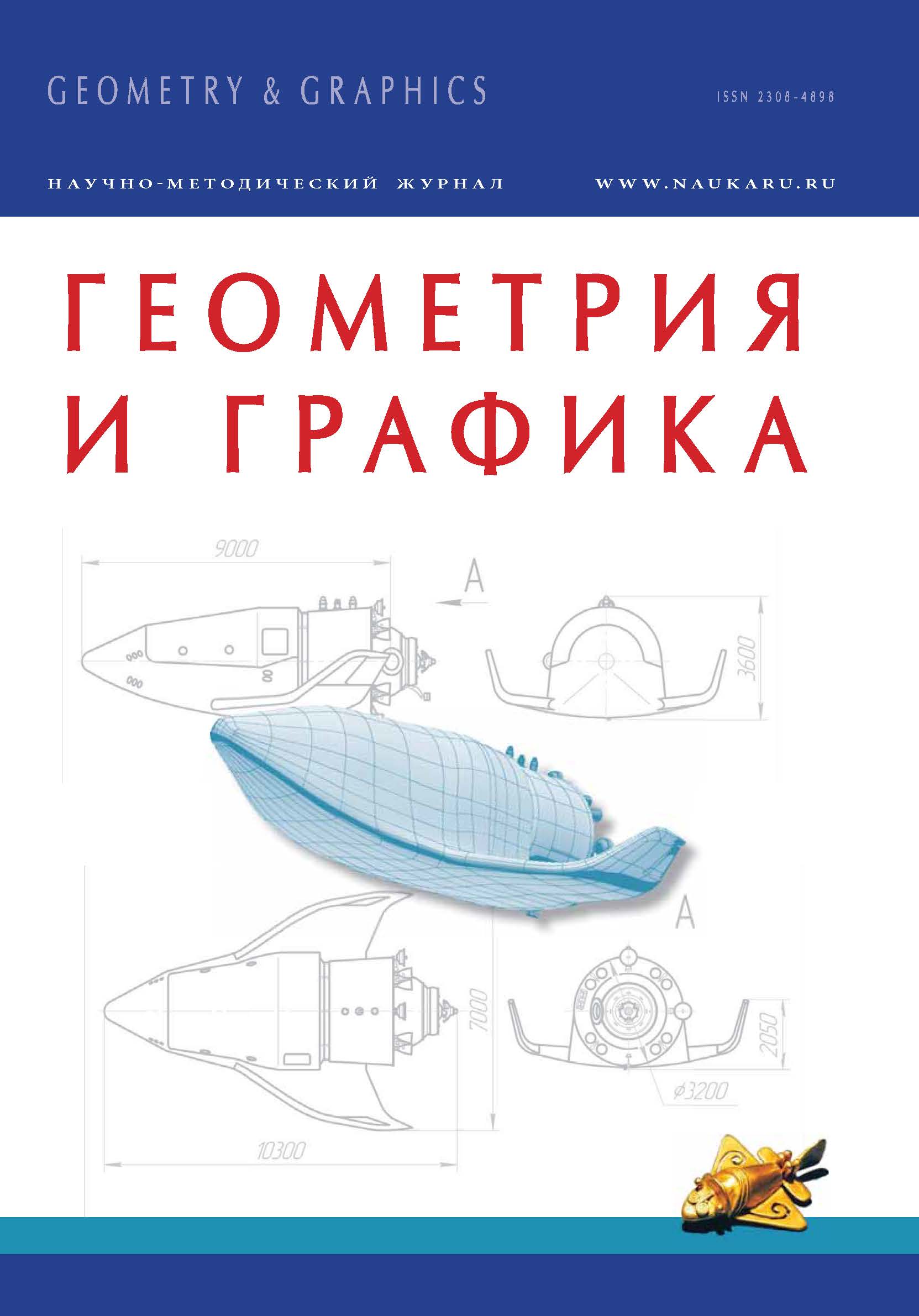Russian Federation
The article is devoted to the construction of spatial model of microsuface module of copper alloy. A real surface has a characteristic roughness associated with the material creating technology, so knowing the geometric parameters of the surface microstructure is very important in studying properties such as microhardness, friction, aero- and gas-dynamic resistance and catalytic activity towards reactions of heterogeneous recombination of atoms in the active centers. To obtain qualitative data on the microsuface morphology, without imposing on the sample to stringent requirements, used a scanning tunneling microscope. Building a model creates a need to recreate the surface topology to study its geometrical properties, expressed through the fractal dimension. Such a simulation should help to study the interaction mechanism between molecules of a rarefied gas with the flying vehicle surface in the solution of gas dynamics problems associated with heat and mass transfer. In MathCAD the calculation of geometric characteristics of a spatial model from the standpoint of the fractal theory for the formation of geometrical shapes and GOST 2789-73 requirements to control their numerical parameters. The example of procedural (algorithmic) construction of geometrical model equivalent to the real is given. It is shown that with sufficient for practical applications accuracy the surface topology can be described by the fractal patterns that take into account irregularities, both at the micro and nanoscale. The proposed algorithm makes it possible to broadcast a method of creating a fractal structure at any detail level. Its positive and negative features based on the midpoint displacement modernized algorithm use are noted. The algorithm correctness for modeling the other materials surfaces geometry is shown.
fractal, scanning tunneling microscopy, surface topology, surface geometry.
1. Aksenova O.A. Fraktal´noe modelirovanie sherohovatoj poverhnosti pri aehrodinamicheskom raschete v razrezhennom gaze [Rough surfaces fractal modeling in the aerodynamic calculation in a rarefied gas]. Aerodinamika [Aerodynamics]. St. Petersburg, St. Petersburg University Publ., 2000. pp. 120-129.
2. Bakhtizin R.Z. Skaniruyushchaya tunnel´naya mikroskopiya - novyj metod izucheniya poverhnosti tverdyh tel [Scanning tunneling microscopy - a new method for studying the surface of solids]. Sorosovskij obrazovatel´nyj zhurnal [Soros educational journal]. 2000, I. 11, pp. 83-89. (in Russian)
3. Brylkin Yu.V., Kusov A.L. Modelirovanie struktury rel´efa real´nyh poverhnostej na osnove fraktalov v aehrodinamike razrezhennyh gazov [Modeling of the real relief surfaces structure, based on fractals in the aerodynamics of rarefied gases]. Kosmonavtika i raketostroenie [Cosmonautics and rocket engineering]. Korolyov, TSNIImash Publ., 2014, I. 3(76), pp. 22-28. (in Russian)
4. Brylkin Y.V., Kusov A.L. Sootnoshenie fraktal´noj razmernosti i razlichnoj sherohovatosti dlya obrazcov medi [Relation between fractal dimension and surface roughness for the copper samples]. Mezhvuz. sb. nauch. tr. Fiziko-himicheskie aspekty izucheniya klasterov, nanostruktur i nanomaterialov [Interuniversity collection of nauchnyh works. Physicochemical aspects of the study of clusters, nanostructures and nanomaterials]. Tver´, Tver. gos. un-t. Publ., 2013, I. 5, pp. 33-38. (in Russian)
5. Gerasimova O.E., Borisov S.F., Procenko S.P. Modelirovanie sherohovatoj poverhnosti [Modeling rough surfaces]. Matematicheskoe modelirovanie [Mathematical modeling]. 2004, V. 16, I. 6, pp. 40-43. (in Russian)
6. Gzhirov R.I. Kratkij spravochnik konstruktora [Brief reference design]. Leningrad, Leningr. otd-nie Mashinostroenie Publ., 1984. 464 p.
7. Grinchenko V.T., Macypura V.T., Snarskij A.A. Fraktaly: ot udivleniya k rabochemu instrumentu [Fractals: from surprise to a working tool]. Kiev, Naukova dumka Publ, 2013. 270 p.
8. Erofeev A.I. O vliyanii sherohovatosti na vzaimodejstvie potoka gaza s poverhnost´yu tverdogo tela [The impact of roughness on gas flow interaction with a solid surface]. Mekhanika zhidkosti i gaza [Fluid mechanics]. Academy of Sciences USSR Izvestiya Publ., 1967, I. 6, pp. 82-89. (in Russian)
9. Zhiharev L.A. Obobshchenie na tryohmernoe prostranstvo fraktalov Pifagora i Koha. Chast´ 1 [A generalization to three-dimensional space of fractal Pythagoras and Koch. Part 1]. Geometriya i grafika [Geometry and Graphics]. 2015, V. 3, I. 3, pp. 24-37. DOI:https://doi.org/10.12737/14417.
10. Ivanov G.S. Nachertatel´naya geometriya [Descriptive geometry]. Moscow, MSFU Publ, 2012. 340 p.
11. Ivanov G.S. Primenenie idei rassloeniya v konstruirovanii kremonovyh preobrazovanij [The application of the stratification idea in the Cremona design transformations]. Nauchnye trudy “Osnovnye napravleniya nauchno-pedagogicheskoj deyatel´nosti fakul´teta landshaftnoj arhitektury” [Proc. of the MSFU “Main directions of scientific and pedagogical activity of landscape architecture faculty”], Moscow, MSFU Publ., 2010, I. 348, pp. 96-100. (in Russian)
12. Mandelbrot B.B. The Fractal Geometry of Nature. New York. W. H. Freeman and Company, 1982. 470 p. (Russ. Ed.: Mandelbrot B. Fraktal´naya geometriya prirody. Moscow, Izhevsk, Izhevskij institut komp´yuternyh issledovanij Publ., NIC «Regulyarnaya i haoticheskaya dinamika» Publ., 2010. 656 p.).
13. Torkhov N.A., Novikov V.A. Fraktal´naya geometriya poverhnostnogo potenciala ehlektrohimicheski osazhdennyh plenok platiny i palladiya [The fractal geometry of surface potential of electrochemically deposited films of platinum and palladium]. Fizika i tekhnika poluprovodnikov [Physics and semiconductors technology]. 2009, V. 43, I. 8, pp. 1109-1116. (in Russian)
14. Feder E. Fractals. New York. Plenum Press. 283 p. (Russ ed.: Feder E. Fraktaly. Moscow, URSS: Lenand Publ., 2014. 256 p.).
15. Shishkin E.I. Modelirovanie i analiz prostranstvennyh i vremennyh fraktal´nyh ob"ektov [Modeling and analysis of spatial and temporal fractal objects]. Ekaterinburg, Ural. gos. un-t Publ., 2004. 88 p.
16. Cauquot P., Cavadias S., Amouroux J. Thermal Energy Accommodation from Oxygen Atoms Recombination on Metallic Surfaces. Journal of Thermophysics and Heat Transfer. 1998, vol. 12, no. 2.
17. De Carpentier, Giliam J.P. Interactively synthesizing and editing virtual outdoor terrain. MA thesis. Delft University of Technology. 2007. Available at: http://www.decarpentier.nl/downloads/nteractivelySynthesizingAndEditingVirtualOutDoorTerrain_report.pdf
18. Ebert D.S., Musgrave F.K., Peachey D., Perlin K., Worley S. Texturing & Modeling: A Procedural Approach. Third Edition. The Morgan Kaufmann Series in Computer Graphics, 2003.
19. Goulard R. On Catalytic Recombination Rates in Hypersonic Stagnation on Heat Transfer. Jet Propulsion. 1958, V. 28, I. 11, pp. 737-745.
20.
21.
22.
23.
24.
25.






